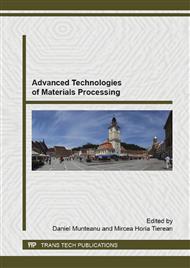p.242
p.254
p.261
p.271
p.282
p.288
p.293
p.303
p.315
Finite Element Modeling of Raw Materials Milling Used in Food Industry
Abstract:
In a series of processes which occur in various processing industries, it is necessary that the raw materials, finished products or intermediate products to be grind to accelerate the technological phase, to obtain a product from raw materials or even only for commercialization the products [1]. Modeling program can be used to study and understand the behavior of an individual grain under compression stress. The results from previous studies have shown that the modeling program can be used [2] for predicting the grain deformation, the compression stress and the energy consumption obtained as a consequence of the grain compression process. This paper presents a comparison of a modeling and experimental study on the influence of the physical properties of a single corn seed on compression grinding process. The mathematical model by finite element method for the corn compression process is made in order to establish the forces that appear to the first cracks of the grain, to determine the maximum force of the corn compression, the deformations of the grain resulted after the compression and the energy consumption during the compression process. For this simulation it was used the mechanical structural module in 3D space of the COMSOL Multiphysics software. The experimental researches were carried out on an individual corn seed, using the materials testing machine Zwick / Roell 5 kN, to which was adapted the compression device [3]. In the experimental researches have been followed the same properties as at the mathematical modeling.
Info:
Periodical:
Pages:
282-287
Citation:
Online since:
October 2015
Authors:
Price:
Сopyright:
© 2015 Trans Tech Publications Ltd. All Rights Reserved
Share:
Citation:


